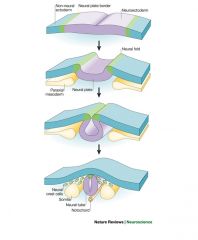![]()
![]()
![]()
Use LEFT and RIGHT arrow keys to navigate between flashcards;
Use UP and DOWN arrow keys to flip the card;
H to show hint;
A reads text to speech;
55 Cards in this Set
- Front
- Back
|
Neuropsychology |
the study of the connection between the nervous system and behavior. Focuses on brain regions. |
|
|
3 Types of neurons in the nervous system |
Afferent (sensory), efferent (motor), interneurons |
|
|
Reflex arcs |
use the ability of internerouns in the spinal cord to relay info to the source of the stimuli while also rerouting it to the brain |
|
|
PNS devision (2 types) |
1. somatic (voluntary) 2. Autonomic (automatic)
|
|
|
autonomic system (2 types) |
1. parasympathetic (rest-digest) 2. sympathetic (fight or flight) |
|
|
brain (3 subdivisions) |
1. hindbrain 2. midbrain 3. forebrain |
|
|
Hindbrain ( 3 parts of the hindbrain) |
1. cerebellum 2. medulla oblongata 3. reticular formation |
|
|
Midbrain (2 parts) |
1. superior colliculi 2. inferior colliculi |
|
|
Forebrain (5 parts) |
1. thalamus 2. hypothalamus 3. basal ganglia 4. limbic system 5. cerebral cortex |
|
|
Thalamus (function) |
relay station for sensory info |
|
|
hypothalmus (function) |
matins homeostasis and integrates with the endocrine system through the hypophyseal portal system and connects to the anterior pituataryb |
|
|
basal ganglia (function) |
refines movements and helps maintain postural stability |
|
|
limbic system (function) |
controls emotion and memory |
|
|
Limbic system (3 parts) |
1. septal nuclei 2. amygdala 3. hippocampus |
|
|
septal nuclei (function) |
involved in the feeling of pleasure, pleasure-seeking behavior and addiction |
|
|
amygdala (function) |
controls fear and aggression |
|
|
hippocampus (function) |
consolidates memories and communicates with other parts of the limbic system through and extension called the fornix |
|
|
cerebral cortex (4 parts) |
1. frontal lobe 2. parietal lobe 3. occipital lobe 4. temporal lobe |
|
|
frontal lobe (function) |
controls executive function, impulse control, long term planning, motor function and speech production |
|
|
parietal lobe (function) |
controls sensations of touch, pressure, temperature, and pain, motor function, and speech production |
|
|
occipital lobe (function) |
visual processing |
|
|
temporal lobe (function) |
controls sound processing, speech perception, memory, and emotion |
|
|
neurotransmitters |
released by neurons to carry a signal to another neuron or effector |
|
|
acetylcholine (function) |
used by the somatic nervous system to move muscles, the PNS and the CNS |
|
|
dopamine (function) |
maintains smooth movements and steady posture |
|
|
endorphins and enkephalins (function) |
natural painkillers |
|
|
epinephrine |
fight and flight acts as a hormone |
|
|
norepinephrine |
fight or flight acts as a neurotransmitter |
|
|
GABA (function) |
brain stabilizer |
|
|
serotonin (function) |
modulates mood, sleep patterns, eating patterns, and dreaming |
|
|
family studies |
look at the relative frequency of a trait within a family compared to the general pop. |
|
|
twin studies |
compare concordance rates between monozygotic and dizygotic twins |
|
|
adoption studies |
compare similarities between adopted children and their adoptive parents, relative to similarities with their bio. parents. |
|
|
How does the nervous system develop? |

It develops through neurulation. The notochord stimulates overlying ectoderm to fold over, creating a neural tube topped with neural crest cells. |
|
|
neural tube (what does it become?) |
central nervous system (CNS) |
|
|
neural crest (what does it become?) |
crest cells spread out throughout the body, differentiating into diff. tissues. |
|
|
primitive reflexes |
exist in infants and disappear with age. |
|
|
gross and fine motor skills (how do they develop?) |
progress head to toe and core to periphery |
|
|
Social skills (how do they develop?) |
parent-oriented to self oriented to other oriented |
|
|
language skills (how do they develop?) |
become more complex |
|
|
adaptive value |
the extent to which a trait or behavior positivily benefits a species by influencing the evolutionary fitness of the species |
|
|
lateral hypothalamus (LH) |
hunger center |
|
|
ventromedial hypothalamus |
provides signal to stop eating |
|
|
anterior hypothalamus |
controls sexual behavior |
|
|
dopamine (associated disorders) |
schizophrenia parkinsons |
|
|
pineal gland fucntion |
circadian rhythm (releases melatonin) |
|
|
Franz Gall |
phrenology, associated development of a trait with growth of the relevant part of the brain |
|
|
Pierre Flourens |
extirpation: concluded the different brain regions have specific functions |
|
|
William James |
father of American psychology pushed for importance of studying adaptions of the individual to his or her enviroment |
|
|
John Dewey |
landmark article on functionalism; argued for studying the entire organism as a whole |
|
|
Paul Broca |
correlated pathology with specific brain regions such as speech production with Broca's area |
|
|
Hermann von Helmoltz |
measured speed of a nerve impulse |
|
|
Sir Charles Sherrington |
inferred the existence of synapsesa |
|
|
adrenal medulla (hormone) |
adrenaline |
|
|
adrenal cortex (hormone) |
cortisol, a stress hormone |

